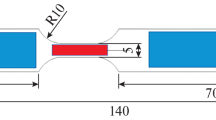Abstract
Tensile properties of polycrystalline nickel have been measured following prestraining at rates between 104 (estimated for electromagnetic forming) and 10-2 min-1. As prestraining speed increases relative to restraining speed, flow stresses at all stages of restraining are increased, although the flow stress difference (between samples subjected to a high speed prestrain and those tested only at a slower, reference rate) decreases as the restraining progresses. Thus, work-hardening rates at any given amount of restrain are progressively less for samples prestrained at progressively higher speeds. At the same time, ultimate strength is little affected by prestrain rate. However, the increased restraining yield stresses and reduced restraining strain-hardening rates result in reduced uniform elonga-tion. The magnitudes of the property changes induced by high-speed prestraining in the present work are modest in comparison to changes reported by others for nickel subjected to large temperature changes between pre-and restraining. Two stage straining also re-sults in the appearance of yield points at the beginning of restraining. Although load drops occur, there is no Lüders band propagation. Several features of those yield points observed in the present work parallel effects reported by earlier workers for unloading-induced yield points.
Similar content being viewed by others
References
W. P. Longo and R. E. Reed-Hill:Scripte Met., 1970, vol. 4, pp. 765–70.
A. S. Appleton and J. S. Waddington:Phil. Mag., 1965, vol. 12, pp. 273–81.
R. N. Orava, H. E. Otto, and R. Mikesell:Met. Trans., 1971, vol. 2, pp. 1675–82.
G. E. Dieter:Response of Metals to High Velocity Deformation, P. G. Shewmon and V. F. Zackay, eds., pp. 409–45, Interscience, New York, 1961.
D. F. Brower:Metals Handbook, vol. 4, p. 256, ASM, Metals Park, 1969.
H. J. Lippmann and H. Schreiner:Z. Metallic., 1964, vol. 55, pp. 737–40.
P. Haasen and A. Kelly:Acta Met., 1957, vol. 5, pp. 192–99.
A. H. Cottrell and R. J. Stokes:Proc. Royal Soc, 1955, vol. A233, pp. 17–34.
F. H. Hammad, C. N. Ahlguist, and W. D. Nix: Mer.Trans., 1970, vol. 1, pp. 2179–83.
Author information
Authors and Affiliations
Additional information
A. S. GÜLEÇ, formerly Visiting Assistant Professor, Department of Materials Science and Engineering, University of Florida, Gainesville, Fla. 31601
Rights and permissions
About this article
Cite this article
Güleç, A.S., Baldwin, D.H. Some effects of prestraining nickel at various rates on its subsequent tensile properties. Metall Trans 4, 1315–1321 (1973). https://doi.org/10.1007/BF02644527
Received:
Issue Date:
DOI: https://doi.org/10.1007/BF02644527




